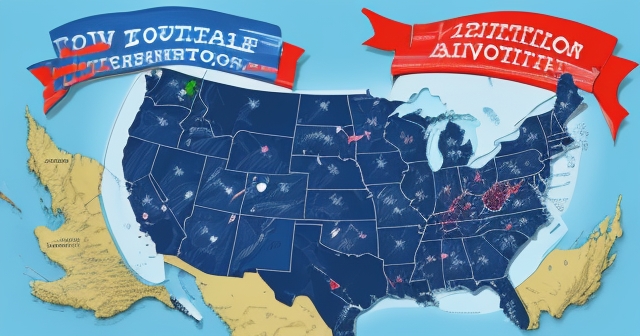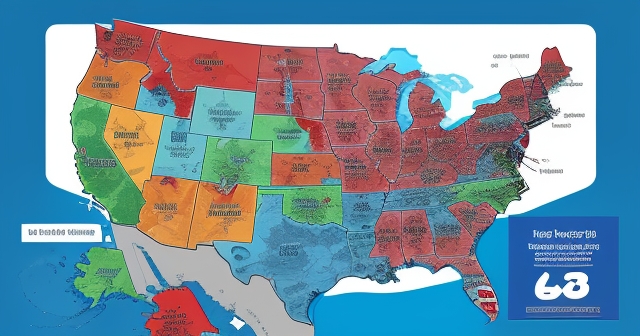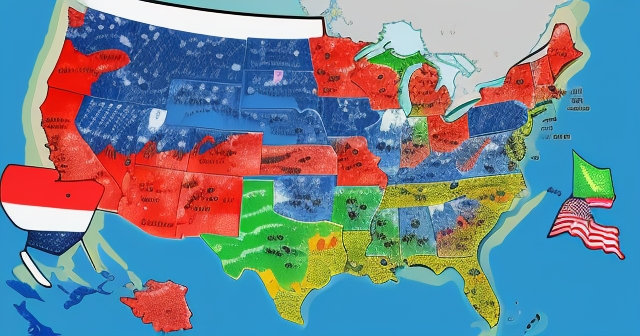
Blue Wave Election: What It Means for 2024 Markets and Policies
Welcome, fellow travelers on the path to financial wisdom. Today, we embark on an exploration of complex terrain – the intersection of politics, economics, and the potential shifts that could ripple through the markets. We’re going to dissect a scenario often discussed in the lead-up to major US elections: the prospect of a “Blue Wave.” What does this political term actually mean, and more importantly, what could it signify for the economic landscape and, by extension, for those navigating investment decisions?
Here are some key points to consider:
- A “Blue Wave” indicates substantial electoral success for the Democratic Party.
- It usually involves winning the Presidency, gaining majority control in Congress, and having the power to enact a legislative agenda.
- The implications of such political success can significantly impact various economic policies.

Understanding the potential for such a wave and the factors influencing it becomes a crucial piece of the puzzle for anyone trying to anticipate market movements or understand the long-term economic outlook.
Table of Contents
ToggleUnderstanding the Concept of a “Blue Wave”
Imagine the political map of the United States. States are often colored red for Republican strongholds and blue for Democratic ones. When we talk about a “Blue Wave” in an election year, we’re not just talking about one party winning the presidency. It’s a term used to describe a scenario where the Democratic Party achieves significant, widespread electoral success.
Specifically, a true blue wave election typically means the Democratic Party manages to win the Presidency, reclaim or hold onto a majority in the House of Representatives, and gain control of the Senate. Achieving this trifecta – unified control of the executive and legislative branches – grants the ruling party considerable power to enact its legislative agenda without significant opposition from the other branch.
Here’s a quick overview of the implications of a Blue Wave:
| Aspect | Implication |
|---|---|
| Presidency | Democratic agenda can be pushed through. |
| House Majority | Easier to pass legislation. |
| Senate Control | Ability to confirm appointments and pass budget bills with less opposition. |
Why is this concept important for us, as individuals interested in financial markets and economics? Because shifts in political power directly influence policy. And policy, whether related to taxation, regulation, infrastructure spending, or social programs, has a tangible impact on businesses, industries, and the broader economy. Understanding the potential for such a wave, and the factors influencing it, becomes a crucial piece of the puzzle for anyone trying to anticipate market movements or understand the long-term economic outlook.
The High Stakes Behind the 2024 Blue Wave Ambition
The pursuit of a blue wave in the 2024 US elections isn’t merely about partisan victory for the Democratic Party; it’s framed by its proponents as being tied to extremely high stakes. Organizations and individuals pushing for this outcome articulate a clear motivation: enabling the passage of transformative policy agendas that they believe are critical for the future of the United States.
Consider the issues frequently highlighted. A unified Democratic government could potentially advance legislation on topics such as strengthening voting rights, making significant investments in climate solutions, codifying reproductive rights (like abortion rights) into federal law, and potentially reshaping the judiciary through appointments. These aren’t minor adjustments; they are changes that could fundamentally alter significant aspects of American society, the environment, and the economy for decades to come.
Conversely, the motivation is also presented as a need to counter opposing political movements, such as the MAGA movement associated with Donald Trump. For supporters of a blue wave, preventing or reversing the policy directions and political norms associated with this movement is a primary driver. This framing of the election as a critical juncture, with profound implications beyond typical policy debates, energizes voter mobilization efforts and fundraising, raising the stakes considerably for all parties involved and, consequently, for the economic sectors that might be affected by proposed policy changes.

Expert Predictions: Goldman Sachs’ 2024 Election Forecast
When major financial institutions weigh in on political outcomes, it catches the attention of investors and analysts. Why? Because these institutions employ teams of economists and political scientists whose job is to anticipate how political shifts might impact markets and the economy. Their forecasts, while not guarantees, offer a perspective grounded in potential financial implications.
In the context of the 2024 election and the potential blue wave, one notable prediction comes from Goldman Sachs. Their analysis offers a specific scenario for the outcome: they predict that Kamala Harris will win the Presidency. Furthermore, they forecast that the Democratic Party will manage to take control of the House of Representatives. However, their prediction diverges from a full “wave” by projecting that Republicans will maintain a majority in the Senate.
This prediction paints a picture of divided government, albeit with a shift in the balance of power. A Democratic presidency working with a Democratic House could still pursue significant parts of their agenda, but a Republican-controlled Senate would act as a substantial check, requiring compromise or limiting the scope of legislation. For investors, this kind of forecast from a firm like Goldman Sachs isn’t just political commentary; it’s an input into models that assess regulatory risk, potential spending priorities, and overall economic trajectory under different political configurations. It suggests that while some elements of a blue wave might materialize (Presidency, House), the full force required for sweeping legislative changes might be tempered by Senate composition.
| Forecast Element | Prediction |
|---|---|
| Presidency | Kamala Harris winning |
| House of Representatives | Democrats gaining control |
| Senate | Republicans maintaining majority |
The Influence of Economic Headwinds on Voter Sentiment
Elections are often influenced by the economic mood of the country. Voters tend to evaluate the performance of the incumbent party based on their personal financial situation and the perceived health of the broader economy. This makes economic indicators critical factors in predicting electoral outcomes, and the 2024 cycle is no different.
The Goldman Sachs analysis, while predicting a Kamala Harris victory and Democratic House gain, also highlighted significant economic headwinds that could potentially challenge the Democratic path to a blue wave. What kind of headwinds are we talking about? The analysis specifically mentioned recent stock market volatility (described as “mayhem”), rising unemployment data, and persistent inflation rates.
Key economic indicators to monitor include:
- Stock Market Volatility: Can influence investor confidence.
- Unemployment Rates: Reflect the job market’s health.
- Inflation Rates: Affect purchasing power and cost of living.

How do these factors translate into potential challenges for the Democratic candidate and the push for a blue wave? High inflation erodes purchasing power, making everyday life more expensive for citizens. Rising unemployment signals job market weakness and economic uncertainty. Stock market volatility can impact retirement accounts and overall investor confidence. These conditions can fuel voter dissatisfaction and make them more receptive to opposition messaging, particularly economic narratives that focus on hardship or the perceived failures of current economic policies. For example, Donald Trump’s “America First” messaging or focus on economic grievances could resonate more strongly if voters are feeling the pinch from these economic pressures. Understanding this connection between economic data and voter sentiment is vital for appreciating the complexities of the election forecast.
Building the Wave: Democratic Political Strategy and the Ground Game
Predictions from financial institutions like Goldman Sachs provide a potential outcome based on current data and models, but achieving a blue wave is not passive; it requires deliberate, extensive political strategy and execution on the ground. The Democratic Party and allied organizations are engaged in sophisticated efforts designed to turn potential into reality. At the heart of this effort is a recognition that elections are won by mobilizing voters, particularly in key areas.
One of the most emphasized strategic components mentioned in the analysis is a significant investment in voter turnout efforts, particularly in critical battleground states and, notably, in rural counties within those states. Historically, rural areas have often leaned Republican. The strategy here represents an intentional focus on either persuading voters in these areas or significantly increasing turnout among the existing Democratic base who might feel overlooked. This isn’t a small undertaking; it requires substantial resources, skilled organizers, and tailored messaging.
| Strategy Component | Goal |
|---|---|
| Voter Turnout Investment | Increase participation in rural areas. |
| Localized Outreach | Engage community members effectively. |
| Organizational Capacity Building | Strengthen ground game logistics. |
Why this focus on rural voters? In close elections, every vote counts, and seemingly small shifts in turnout or support in less populated areas can have an outsized impact on state-wide totals, especially in states with razor-thin margins. Organizations like Movement Voter Project (MVP) and Blue Wave America are key players in this ground game, focusing their efforts and directing funding towards local groups with established roots and proven track records in these challenging areas. This strategic shift underscores the complexity of modern campaigning – it’s not just about national narratives or urban centers; it’s increasingly about micro-targeting and deep engagement in every corner of the map, including communities that might not traditionally be considered Democratic strongholds.
Tactics for Mobilization: From Digital Tools to Deep Canvassing
Translating strategy into votes requires a multitude of specific tactics, leveraging both modern technology and old-fashioned human connection. The effort to achieve a blue wave involves a multi-pronged approach aimed at identifying, registering, persuading, and ultimately turning out voters. This is the operational side of the campaign, where theory meets the pavement (or the gravel road, in the case of rural areas).
The tactics mentioned include utilizing cutting-edge voter turnout technology and modern digital tools. This involves data analysis to identify potential voters, personalized digital messaging, online registration drives, and using social media for mobilization and information dissemination. In today’s world, a sophisticated digital presence is non-negotiable for reaching voters where they are, particularly younger demographics.
However, the strategy also emphasizes high-touch methods. We see mentions of employing expert on-the-ground organizers and staffers, building networks of volunteers and activists, and focusing on direct human connection. Techniques like deep canvassing – engaging voters in longer, more empathetic conversations about their values and concerns – are highlighted as ways to build trust and potentially shift opinions. Personal storytelling is also key, connecting abstract policy issues to real-life impacts experienced by individuals. This blend of high-tech efficiency and labor-intensive personal interaction is seen as essential for overcoming apathy, countering misinformation, and ensuring target voters actually cast their ballots on election day or during early voting periods. It’s about making politics personal and relevant to individual lives.

The Campaign Lifecycle: Understanding the MVP Model Phases
Successful large-scale political campaigns don’t just happen spontaneously; they are meticulously planned and executed over many months, often following structured models. The analysis of the Democratic strategy mentions a 12-month plan, sometimes referred to through models like the Movement Voter Project (MVP) framework, which breaks down the path to the election into distinct phases. Understanding these phases gives us insight into the methodical approach required to build toward a potential blue wave.
The plan typically includes phases such as:
- Catalyze: This initial phase involves laying the groundwork. It’s about developing strategy, building organizational capacity, recruiting key staff and volunteers, and securing initial funding. Think of this as setting the foundation.
- Galvanize: As the election cycle progresses, this phase focuses on identifying potential supporters, registering new voters (particularly targeting demographics like young voters, voters of color, and other key groups), and engaging voters during primaries to build momentum and refine messaging. This is where the voter file starts to become a living document.
- Mobilize: This is the core of the “get-out-the-vote” effort (GOTV). It involves direct voter engagement through calls, texts, door knocking, mail, and digital ads. It includes persuasion efforts targeting undecided or potentially cross-pressured voters. A major focus is on encouraging early voting and making sure voters have plans to cast their ballots.
- Engame: The final stretch leading up to Election Day. This phase is the peak of the GOTV effort, ensuring every identified supporter votes. It also includes crucial work on election protection – monitoring polling places, addressing potential voter suppression issues, and preparing for potential legal challenges. Finally, it involves immediate post-election evaluation and beginning planning for the subsequent year (in this case, 2025 policy objectives).
| Phase | Description |
|---|---|
| Catalyze | Laying the groundwork for the campaign. |
| Galvanize | Engaging with voters and building support. |
| Mobilize | Executing the get-out-the-vote strategy. |
| Engame | Final preparations and ensuring voter turnout. |
This phased approach demonstrates that the push for a blue wave is a sustained effort, not just a few weeks of campaigning. It requires long-term investment, coordination across numerous groups, and adaptability as the political and economic landscape evolves. For anyone watching the election, understanding these phases helps contextualize the activities you see – from registration drives early on to the intense push for votes in the final days.
Investing in the Infrastructure: Grassroots Organizations and Funding
A critical, though often less visible, component of any major political effort like aiming for a blue wave is the underlying infrastructure of organizations and funding that supports the ground game. National campaigns get headlines, but the work of turning out votes happens locally, state by state, and county by county.
The strategy emphasizes directing resources to a network of grassroots organizations and local groups. These are organizations with deep ties to specific communities – be it rural voters in Pennsylvania, voters of color in Georgia, young people in Arizona, or union households in the Midwest. They understand the local political terrain, have existing relationships with community members, and possess the cultural competence to engage voters effectively in their specific contexts. The analysis highlights investment across various scales of organizations:
| Organization Type | Characteristics |
|---|---|
| Major Multi-State Organizations | Focus on broad geographic strategies. |
| Small-to-Mid National Groups | Adaptable strategies in various regions. |
| Major State-Level Organizations | Localized strategies with statewide impact. |
| Mid-Sized Local Organizations | Effective grassroots mobilization. |
| Micro-Local Groups | Hyper-local engagement for communities. |
This diversified investment strategy, championed by entities like Movement Voter Project and Blue Wave America, aims to ensure that resources reach the front lines where voter contact actually happens. It’s based on the principle that empowering trusted community voices is more effective than relying solely on top-down directives. The funding directed towards these groups supports everything from paying local organizers and covering operational costs to printing literature and running local digital ads. For those observing the political spending landscape, tracing these investments reveals where campaigns believe the marginal dollar can have the biggest impact on increasing voter turnout and achieving the desired electoral outcome, such as flipping a crucial state like Pennsylvania or boosting the chances of candidates like Kamala Harris.
The Geographic Battlegrounds: Swing States and Key Demographics
Elections in the United States are not decided by the national popular vote but by winning individual states to secure electoral votes (for the Presidency) and by winning specific districts and states for Congress. Therefore, the push for a blue wave is heavily concentrated on specific geographic battlegrounds and targeting key voter demographics within those areas.
The analysis identifies the “Big Nine” states as central to the Presidency and Senate races: Arizona, Georgia, Michigan, Nevada, North Carolina, Pennsylvania, Wisconsin, Ohio, and Montana. These are the classic swing states where the outcome is uncertain and where both parties invest heavily. Winning a majority of these states is seen as essential for a Democratic presidential victory and crucial for potentially flipping the Senate.
Key demographics to focus on include:
- Young Voters
- Voters of Color
- Women
- LGBTQ+ Individuals
- Immigrants
- Cross-Pressured White Voters
- Rural Voters
- Working-Class Voters

Within these states, the strategy involves granular focus on specific voter groups. The analysis mentions targeting a wide array: young voters, voters of color, women, LGBTQ+ individuals, immigrants, cross-pressured white voters, male voters, union households, rural voters, working-class voters, and persuadable independents. Each group requires tailored messaging and specific outreach tactics. For example, engaging rural Democrats in Wisconsin requires a different approach than mobilizing young voters in Arizona or reaching out to voters of color in Georgia. This demographic focus within geographic priorities defines the tactical landscape of the campaign, as organizations work to boost turnout and support from specific segments of the population needed to build the winning coalition for a potential blue wave.
Connecting the Dots: Policy Ambition and Electoral Success
Ultimately, the drive for a blue wave election is intrinsically linked to the policy goals of the Democratic Party. As we discussed earlier, achieving unified control of the government is seen as the most viable path to passing significant, often transformative, legislation. This connection between electoral success and policy ambition is a powerful motivator for activists, donors, and voters alike.
Consider the issues at stake, which go beyond typical budgetary debates. Advocates for a blue wave explicitly tie the election outcome to the ability to protect or expand rights (like reproductive justice and voting rights), address existential threats (like climate change through investments in green technology and infrastructure), and potentially make significant social and economic reforms (like student debt cancellation or strengthening union protections). The list of potential policy outcomes forms the core promise of a Democratic victory and is used to energize the base and persuade voters that their participation is essential.
The challenges linked to policy ambition include:
- Polarizing Effects: Major reforms may motivate opposition.
- Communication Strategies: Effectively conveying policies to diverse voters.
- Voter Engagement: Encouraging participation across various demographics.

However, the link is also a challenge. Sweeping policy agendas can be polarizing, motivating opposition just as much as they motivate supporters. The effectiveness of tying policy ambition to electoral strategy depends heavily on communicating these goals in a way that resonates with a broad enough coalition of voters across different demographics and geographies. It requires convincing voters in states like Pennsylvania and Michigan that the proposed policies will improve their lives, while simultaneously mobilizing specific base voters in urban centers and rural areas. This intricate dance between articulating a bold policy agenda and executing a winning electoral strategy is fundamental to the pursuit of a blue wave.
Navigating Uncertainty: Economic Reality vs. Political Aspiration
As we’ve explored, the push for a blue wave is a highly organized, well-funded effort with clear strategic goals and targeted tactics. However, as the Goldman Sachs analysis reminds us, external factors, particularly economic conditions, introduce significant uncertainty into the equation. Political aspirations must navigate the reality of voters’ lived experiences, and the economy plays a dominant role in shaping those experiences.
The interplay between the detailed ground game efforts and broader economic trends is complex. Can sophisticated voter mobilization and persuasion tactics overcome widespread frustration stemming from high inflation or job insecurity? The degree to which economic headwinds dampen voter sentiment and turnout, or conversely, the degree to which effective campaigning can mitigate these negative effects, will be crucial determinants of the 2024 election outcome. The opposition, particularly Donald Trump and MAGA Republicans, will undoubtedly focus heavily on economic critiques, framing the election as a referendum on the current economic state.
Furthermore, the presence of third-party candidates like Robert F. Kennedy Jr., Jill Stein, or Cornel West, while not predicted to win, can play a spoiler role, potentially drawing votes from either major candidate and impacting margins in key states. This adds another layer of complexity to predicting whether a full blue wave or even partial victories predicted by analysis like Goldman Sachs’ will materialize.
Ultimately, while models and strategies provide frameworks, the outcome of a complex event like a US general election is always subject to unforeseen events and the aggregated decisions of millions of individual voters. For those tracking these developments from an investment perspective, understanding the forces at play – from the strategic blueprint for a potential blue wave to the economic pressures influencing the electorate – is essential for forming a comprehensive view of the potential future landscape.
Thank you for joining us on this deep dive into the dynamics shaping the potential blue wave election of 2024. We hope this exploration of the strategies, predictions, and economic context has provided valuable insights for your own understanding of the intersection of politics and markets.
blue wave election FAQ
Q:What is a Blue Wave election?
A:A Blue Wave election signifies significant electoral success for the Democratic Party, often resulting in control of the Presidency, House, and Senate.
Q:How does economic sentiment affect voter behavior?
A:Voter sentiment is often influenced by economic conditions such as inflation and unemployment rates, impacting their voting decisions.
Q:What strategies are used to mobilize voters?
A:Strategies include using digital tools, deep canvassing, and focusing on grassroots organizations to enhance voter turnout.
You may also like
Calendar
| 一 | 二 | 三 | 四 | 五 | 六 | 日 |
|---|---|---|---|---|---|---|
| 1 | 2 | 3 | 4 | 5 | 6 | 7 |
| 8 | 9 | 10 | 11 | 12 | 13 | 14 |
| 15 | 16 | 17 | 18 | 19 | 20 | 21 |
| 22 | 23 | 24 | 25 | 26 | 27 | 28 |
| 29 | 30 | 31 | ||||
發佈留言
很抱歉,必須登入網站才能發佈留言。